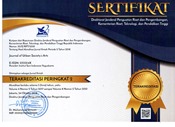The Transition of Dramaturgy During Pandemic: From Staging to Streaming
Abstract
This study discusses the transition of performances dramaturgy during the Covid-19 pandemic from analog to digital formats, from live performances commonly called staging to mediated performances which can be called performance streaming. The aim of study is to understand the application of ‘dramaturgical tactics’; and the reasons. Applying the dramaturgical analysis method investigation is directed at the transformation process from the basic concept of the performance to the practice of its presentation. The research departs from the premise that a dramaturgical process, namely the pre-production, production, and presentation of performance is permanently connected by a dramaturgical awareness. The analysis was carried out: (1) the idea of streaming; (2) performance technique; and (3) the form of performance streaming. Research shows that the critical changes in dramaturgy during the pandemic were triggered by the necessity to shift the mode of performance from staging to streaming, resulting in three dramaturgical awareness about transition, namely: (1) medium: from analog to digital performance; (2) creativity: from performer to content creator; and (3) the spectatorship: from spectator to voyeur.
Perubahan Dramaturgi di Masa Pandemi: Dari Pementasan ke Siaran. Artikel ini membahas perihal transisi dramaturgi pertunjukan di masa pandemi Covid-19 dari format analog ke format digital, dari moda pertunjukan langsung yang lazim dinamakan pementasan ke pertunjukan termediasi yang dapat dinamakan siaran pertunjukan. Tujuannya untuk memahami bentuk penerapan ‘siasat dramaturgi’ serta alasan di baliknya. Mengunakan metode analisis dramaturgis, berupa investigasi atas proses transformasi dari konsep dasar pertunjukan menuju praktik presentasinya, penelitian berangkat dengan premis bahwa suatu proses dramaturgi, yakni tahap pra-produksi, produksi, dan presentasi pertunjukan selalu terhubung oleh satu kesadaran dramaturgis. Analisis dilakukan terhadap: (1) gagasan siaran pertunjukan; (2) teknik siaran pertunjukan; dan (3) bentuk siaran pertunjukan. Penelitian menunjukkan bahwa, perubahan penting dramaturgi di masa pandemi dipicu oleh suatu keharusan untuk memindahkan moda pertunjukan dari pementasan ke siaran, menghasilkan tiga kesadaran dramaturgis tentang peralihan, yakni: (1) medium: dari pementasan analog ke siaran digital; (2) kreativitas: dari penampil menjadi pembuat konten; dan (3) kepenontonan: dari spektator menjadi voyeur.
Keywords
Full Text:
PDFReferences
Agustina, A. (2016). Transformasi Naskah Lakon Macbeth (1603-1607) Karya William Shakespeare Ke Film Throne of Blood atau Kumonosu-Jo (1957) Karya Akira Kurosawa. Journal of Urban Society’s Arts, 3(1), 1–9. https://doi.org/10.24821/jousa.v3i1.1471
Behrndt, S. K. (2010). Dance, dramaturgy and dramaturgical thinking. Contemporary Theatre Review, 20(2), 185–196. https://doi.org/10.1080/10486801003682393
Birowo, P. (2018). Teater ‘Tanpa-Kata’ Dan ‘Minim-Kata’ Di Kota Padang Dekade 90-An Dalam Tinjauan Sosiologi Seni. Jurnal Ekspresi Seni, 16(2), 314–335.
Cantini, C. (2018). Wacana Pos-Dramatik dalam Teater Pooh-Pooh Somatic: on Crowd of Biographies Karya Kalanari Theater Movement Yogyakarta. Tamumatra; Jurnal Seni Pertunjukkan, 1(1), 1–10. https://doi.org/10.29408/tmmt.v1i1.1124
Cecariyani, S. A., & Sukendro, G. G. (2019). Analisis Strategi Kreatif dan Tujuan Konten Youtube (Studi Kasus Konten prank Yudist Ardhana). Prologia, 2(2), 495. https://doi.org/10.24912/pr.v2i2.3735
Dixon, S. (1999). Digits, Discourse, and Documentation: Performance Research and Hypermedia. TDR/The Drama Review, 43(1), 152–175. https://doi.org/10.1162/105420499320582213
Dixon, S. (2011). Researching Digital Performance: Virtual Practice. In B. Kershaw & H. Nicholson (Eds.), Research Methods in Theatre and Performance (pp. 41–62). Edinburgh University Press.
Hendriyana, H., Kudya, K., & Atamtajani, A. (2020). Designing Marine-Park-Inspired Batik Patterns and Their Application on Masks as Pangandaran Tourism Souvenirs during Covid-19 Pandemic. Journal of Urban Society’s Arts, 7(2), 74–82. https://doi.org/10.24821/jousa.v7i2.4502
Hooley, T., Marriott, J., & Wellens, J. (2012). Introduction. In What is Online Research?: Using the Internet for Social Science Research. (Research M, pp. 1–6). Bloomsbury Academic. https://doi.org/10.5040/9781849665544.ch-001
Ledger, A. J., Ellis, S. K., & Wright, F. (2011). The Question of Documentation: Creative Strategies in Performance Research. In B. Kershaw & H. Nicholson (Eds.), Research Methods in Theatre and Performance (pp. 162–187). Edinburgh University Press.
Malna, A. (2020). Teks-Teks Erotik dalam Isolasi Wabah Makna [Erotic Texts in Isolation of the Plague Meaning]. In Dewan Kesenian Jawa Timur (Ed.), Seni di Tengah Pandemi; Siasat dan Strategi Seni Menghadapi Ancaman Wabah Covid-19 [Art in the Midst of a Pandemic; Art Tactics and Strategies to Deal with the Threat of the Covid-19] (pp. 33–46). Dewan Kesenian Jawa Timur (DKJT).
Ninditya, R. (2020). Membayangkan Ekosistem Seni Pascapandemi. 18 Juni 2020. https://koalisiseni.or.id/membayangkan-ekosistem-seni-pascapandemi/
Podmaková, D. (2015). Is Theatre Under The Influence of New Media. Culture, 5(12). https://journals.cultcenter.net/index.php/culture/article/view/183
Pramayoza, D. (2013). Dramaturgi Sandiwara: Potret Teater Populer dalam Masyarakat Poskolonial. Penerbit Ombak.
Pramayoza, D. (2020a). Diorama Kota Bahagia: Pandangpanjang dalam Esai. Dinas Perpustakaan dan Kearsipan Kota Padang Panjang.
Pramayoza, D. (2020b). Memperbaharui Makna Perjumpaan: Festival dan Seni Pertunjukan di Tengah Pandemi. In D. K. Alka, H. Fansuri, & M. Nizar (Eds.), Wajah Kemanusiaan di Tengah Wabah: Percikan Pemikiran (pp. 243–257). Penerbit Quantum dan Jaringan Islam Berkemajuan.
Pramayoza, D., Simatupang, G. R. L. L., & Murgiyanto, S. (2018). Proses Dramaturgi Dari Teks Sastra Syair Lampung Karam Ke Teks Pertunjukan Teater Under the Volcano. Jurnal Kajian Seni, 4(2), 206–225. https://doi.org/10.22146/jksks.46448
Raditya, M. H. B. (2020). Urfear Huhu and the Multitude of Peer Gynts Sebagai Tawaran Liveness Pada Pertunjukan Virtual. Jurnal Kajian Seni, 07(01), 37–53. https://doi.org/10.22146/jksks.63090
Reaney, M. (2010). Virtual Reality and the Theatre: Immersion in Virtual Worlds. Digital Creativity, August, 28–31. https://doi.org/10.1076/digc.10.3.183.3244
Shaw, D. (2012). Digital Drama: The technology transforming theatre. https://www.bbc.com/news/technology-17079364
Simatupang, L. (2013). Pergelaran; Sebuah Mozaik Penelitian Seni-Budaya (D. Pramayoza (ed.)). Jalasutra.
Sofiyanti, N., & Rianto, P. (2021). Media Sosial Dan Praktik-Praktik Voyeurism. Jurnal Mahasiswa Komunikasi Cantrik, 1(1), 55–66. https://doi.org/10.20885/cantrik.vol1.iss1.art5
Tajtakova, M. (2011). Theatre in the Digital Age: When Technology Meets the Arts. Inproceedings TheatreIT. http://www.cutn.sk/Library/proceedings/km_2014/PDF FILES/Tajtakova.pdf
Tukan, B. (2020). Teater Pada Panggung Digital. 8 Oktober. https://www.bertotukan.com/2020/10/08/teater-pada-panggung- digital/
Webb, L. M. (2017). Online Research Methods, Qualitative. The International Encyclopedia of Communication Research Methods, January, 1–9. https://doi.org/10.1002/9781118901731.iecrm0173
Whitton, D. (2009). The Practical Turn in Theatre Research. Forum Modernes Theater, 24(1), 77–88.
DOI: https://doi.org/10.24821/jousa.v9i1.6697
Refbacks
- There are currently no refbacks.

This work is licensed under a Creative Commons Attribution 4.0 International License. ISSN 2355-2131 (print) | ISSN 2355-214X (online).







